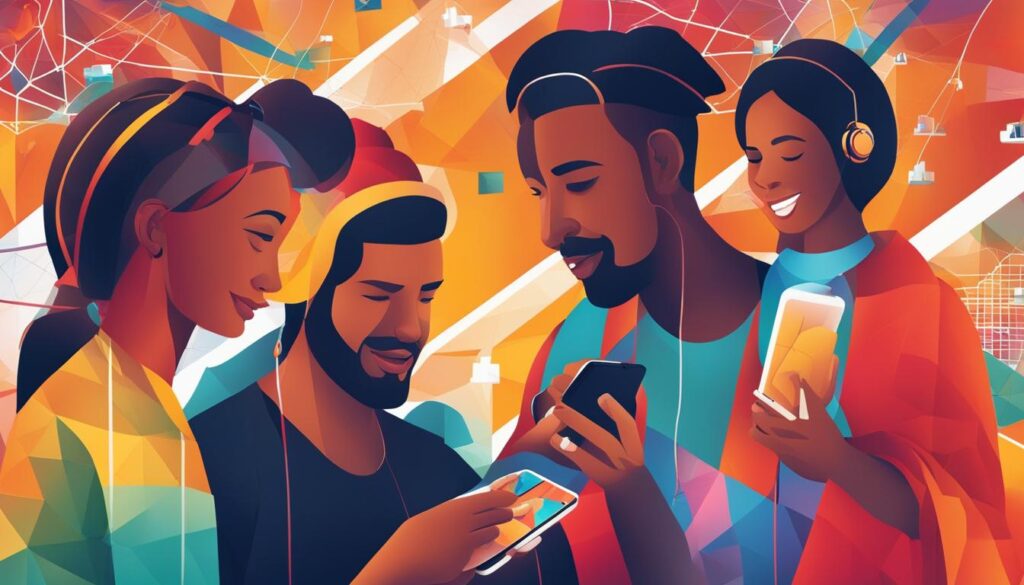Smartphones & Societal Issues: Uncovering Links
Did you know that the average person spends over 3 hours on their smartphone every day? That’s more than 1,000 hours a year! The impact of smartphones on society cannot be overstated, as they have become an integral part of our daily lives, affecting everything from our communication to our mental health. In this article, we will delve into the complex relationship between smartphones and societal issues, exploring the negative consequences of excessive smartphone use and its wide-ranging implications. Join us as we uncover the links between smartphones and the challenges they pose to our well-being and society as a whole.
Introduction to the Pervasiveness of Smartphones in Modern Society
In today’s rapidly evolving digital landscape, smartphones have become an integral part of our daily lives. From communication and entertainment to productivity and convenience, these devices have revolutionized the way we interact with the world around us. In this section, we will delve into the rise of smartphone usage across demographics, the transformation of smartphones from luxury items to ubiquitous necessities, and the core functions that have made them indispensable in shaping societal norms and behaviors.
The Psychological Impacts of Smartphones on Communication

In today’s digital age, smartphones have become an integral part of our lives, transforming the way we communicate with one another. However, their widespread use has also given rise to various psychological impacts on our interpersonal interactions and communication skills.
Alterations in Interpersonal Interactions and Conversational Depth
Smartphones have significantly altered the landscape of interpersonal interactions. With the constant presence of smartphones, face-to-face conversations have taken a backseat, as people are more engrossed in their digital devices. This shift in communication dynamics has led to a decline in conversational depth and genuine engagement with others.
Instead of deep, meaningful conversations and connections, interactions have become fragmented and superficial. The constant distractions and interruptions from smartphone notifications hinder our ability to fully engage in conversations and understand subtle nonverbal cues. As a result, the quality of communication has suffered, impacting our ability to form and maintain meaningful relationships.
Smartphones and the Decline of Face-to-Face Communication Skills
The overreliance on smartphones has also led to a decline in face-to-face communication skills. As more interactions occur through screens and keyboards, the art of effective face-to-face communication is gradually eroding. Skills such as active listening, maintaining eye contact, and interpreting body language are becoming less practiced and valued.
Furthermore, the convenience of smartphone communication has resulted in decreased motivation to engage in face-to-face conversations. People may prefer the ease of sending a text message or instant message, rather than having a real-time conversation. This shift in communication preferences can hinder our ability to develop essential social skills and navigate complex social dynamics effectively.
| Psychological Impacts of Smartphones on Communication | |
|---|---|
| Alterations in Interpersonal Interactions | Decline in Face-to-Face Communication Skills |
| – Fragmented and superficial conversations | – Decreased motivation for face-to-face conversations |
| – Lack of genuine engagement and understanding | – Erosion of essential social skills |
| – Impact on relationship building |
How could smartphones be linked to societal problems
Smartphones have become an indispensable part of our daily lives, shaping how we communicate, work, and navigate the world. While these devices offer convenience and connectivity, they are not without their consequences. The widespread use of smartphones has raised concerns about their potential impact on society and the various societal problems that may arise as a result.
One of the primary consequences of excessive smartphone usage is the negative impact on mental health. Research suggests that excessive screen time and social media usage can contribute to feelings of anxiety, depression, and loneliness. The constant exposure to curated online content and the pressure to maintain a certain online image can exacerbate these issues, leading to detrimental effects on individual well-being.
Moreover, smartphones have been linked to a decline in face-to-face communication skills, which are essential for building meaningful relationships and fostering social cohesion. With the rise of smartphone dependency, individuals may prefer online interactions over in-person connections, resulting in a reduced ability to develop and maintain interpersonal relationships.
Another societal problem associated with smartphones is the impact on productivity and work-life balance. The constant availability and accessibility of smartphones can blur the boundaries between personal and professional life, leading to increased stress and burnout. Additionally, the distraction and time spent on smartphone activities can hinder productivity, affecting overall work performance.
Furthermore, smartphones have contributed to an increase in distracted driving incidents, posing a significant risk to road safety. The temptation to use smartphones while driving has resulted in accidents, injuries, and even fatalities. This highlights the need for increased awareness and responsible smartphone usage to ensure the safety of individuals on the road.
By understanding these consequences of smartphone usage on society, we can begin to address the challenges they pose. Initiatives promoting digital well-being, such as setting boundaries for smartphone use and fostering mindful usage, can help mitigate the negative effects. Additionally, raising awareness about the potential societal problems associated with excessive smartphone usage can encourage individuals to adopt healthier habits and find a balance between technology and human interaction.
Exploring Privacy Concerns and Data Security in the Smartphone Era

In this section, we will delve into the privacy concerns and data security issues associated with smartphones in the digital era. As our reliance on smartphones continues to grow, so do our concerns about the safety and privacy of our personal information.
Rising Threats to Personal Privacy on Mobile Platforms
Smartphones have become a treasure trove of personal data, from our contacts and messages to our browsing history and location information. Unfortunately, this wealth of data also makes smartphones an attractive target for cybercriminals and hackers.
The rise of mobile platforms has brought about an increase in privacy breaches, exposing users to various threats such as data breaches, identity theft, and unauthorized access to personal information. With more and more apps requesting permission to access our personal data, it is essential to be vigilant about protecting our privacy.
Data breaches have become all too common, with even major companies falling victim to cyberattacks. The consequences of these breaches can be severe, leading to financial loss, reputational damage, and emotional distress for the individuals affected.
How Smartphones Contribute to Data Vulnerability
Smartphones are designed to be convenient and connected, allowing us to access a wealth of information and services at our fingertips. However, this convenience comes at a cost in terms of data vulnerability.
Many smartphone apps collect and store vast amounts of personal data, including our contacts, location, browsing habits, and even biometric information. While this data can enhance the functionality and personalization of our smartphones, it also increases the risk of data breaches and unauthorized access.
In addition, the always-on nature of smartphones means that our devices are constantly transmitting and receiving data, creating opportunities for interception and data theft. Public Wi-Fi networks, which are commonly used with smartphones, can be particularly vulnerable to man-in-the-middle attacks and other security breaches.
To mitigate these risks, it is crucial to take steps to enhance data security on our smartphones. This includes regularly updating our devices with the latest security patches, using strong and unique passwords, and being cautious about the apps we install and the permissions we grant.
| Steps to Enhance Data Security on Smartphones | |
|---|---|
| 1. Regularly update your device software | Keep your smartphone’s operating system and applications up to date to ensure you have the latest security patches. |
| 2. Use strong and unique passwords | Use a combination of letters, numbers, and special characters for your device and app passwords. Avoid using common passwords or reusing passwords across multiple accounts. |
| 3. Be cautious about app permissions | Review the permissions requested by apps before granting access to your personal data. Only give permissions that are necessary for the app’s intended functionality. |
| 4. Install antivirus and security apps | Consider installing reputable antivirus and security apps on your smartphone to protect against malware, phishing attempts, and other security threats. |
| 5. Use secure Wi-Fi networks | Avoid connecting to public Wi-Fi networks when transmitting sensitive data. If you must connect to public Wi-Fi, use a virtual private network (VPN) to encrypt your connection. |
Social Media’s Influence on Youth and the Role of Smartphones
In today’s digital age, social media has significantly influenced the behavior of young individuals, with smartphones playing a crucial role in facilitating this influence. The addictive nature of social media platforms and excessive smartphone usage among teenagers has raised concerns regarding their psychological well-being and societal impact.
Link between Smartphone Addiction and Social Media Usage in Teens
Studies have shown a strong correlation between smartphone addiction and the excessive use of social media platforms among teenagers. The constant need to stay connected and receive validation through likes, comments, and shares can lead to addictive behaviors and increased smartphone dependency. The widespread availability of smartphones and the easy access to social media platforms have amplified this phenomenon, with detrimental consequences on the overall well-being of young individuals.
The Psychological Consequences of Constant Digital Connection
The constant digital connection enabled by smartphones and social media has profound psychological consequences on youth behavior. Excessive use of social media can contribute to feelings of anxiety, depression, and low self-esteem, as young individuals compare their lives to the carefully curated highlight reels of others. Additionally, the continuous exposure to cyberbullying and online harassment can further exacerbate these psychological issues, posing a significant threat to the mental health of young individuals.
To illustrate this complex relationship between social media, smartphone addiction, and youth behavior, consider the following statistics:
| Statistic | Percentage |
|---|---|
| Teens who use social media for more than five hours per day | 32% |
| Teens experiencing symptoms of depression due to social media use | 27% |
| Teens who have been cyberbullied | 20% |
These statistics highlight the significant impact of social media on youth behavior and the urgency to address the psychological consequences of constant digital connection.
The Ecological Footprint of Smartphone Production and Disposal

In today’s society, smartphones have become an indispensable part of our lives. However, the environmental impact of smartphone production and disposal is often overlooked. In this section, we will delve into the ecological footprint of smartphone manufacturing and explore sustainable alternatives that can mitigate environmental hazards.
Environmental Hazards of Smartphone Manufacturing Processes
Smartphone production involves complex manufacturing processes that contribute to environmental hazards. From the extraction of raw materials to the assembly of components, each stage of the manufacturing process has its own environmental impact. For instance, the mining of minerals such as cobalt and lithium, used in smartphone batteries, often leads to deforestation, soil degradation, and water pollution. Additionally, the energy-intensive production methods and the generation of electronic waste further exacerbate environmental concerns.
According to a study by Greenpeace, the production of one smartphone generates an estimated 85 kilograms of carbon dioxide emissions. This is equivalent to the emissions produced by driving a car for 200 kilometers.
Furthermore, the improper disposal of smartphones poses a significant threat to the environment. E-waste, which includes discarded electronic devices like smartphones, contains toxic substances such as lead, mercury, and cadmium. When these substances leach into soil and water, they can contaminate ecosystems and harm both human and animal health.
Exploring Sustainable Alternatives to Current Industry Practices
The smartphone industry is starting to recognize the importance of sustainable practices and is taking steps to mitigate its environmental impact. One example is the incorporation of recycled materials into smartphone manufacturing, reducing the reliance on newly extracted resources. In addition, eco-friendly packaging and energy-efficient production processes are being implemented to minimize waste and energy consumption.
Moreover, consumer awareness and demand for sustainably produced smartphones are driving companies to adopt more environmentally friendly practices. Brands such as Fairphone are pioneering sustainable smartphone manufacturing by focusing on ethical sourcing, repairability, and longevity. By designing smartphones that are easy to repair and upgrade, they aim to extend the lifespan of devices and reduce electronic waste.
Government regulations and industry standards also play a crucial role in promoting sustainable smartphone production and disposal. Policy initiatives, such as extended producer responsibility, can hold manufacturers accountable for the end-of-life management of their products. Additionally, recycling programs and facilities can incentivize consumers to properly dispose of their old smartphones, facilitating the recycling and recovery of valuable materials.
By embracing sustainable alternatives and promoting responsible consumption and disposal, we can reduce the ecological footprint of smartphone production and contribute to a more environmentally conscious future.
Smartphones as a Tool for Reinforcing Social Inequalities
In today’s digital age, smartphones have become an integral part of our daily lives, with their impact reaching far beyond personal communication and entertainment. While smartphones have the potential to bridge gaps and connect people across different socioeconomic backgrounds, they can also inadvertently reinforce social inequalities. In this section, we will explore how smartphones contribute to social disparities and the barriers they create in terms of access to technology, education, and opportunities.
Access to Technology as a Measure of Socioeconomic Status
Access to smartphones and other digital devices has become a defining factor in determining one’s socioeconomic status. In many societies, having a smartphone is not merely a luxury but a necessity, enabling individuals to stay connected, access information, and participate in the digital world. However, not everyone has equal access to technology, creating a digital divide that disproportionately affects those from marginalized communities or low-income backgrounds.
The cost of smartphones, along with the ongoing expenses of data plans and internet access, can pose significant financial barriers for individuals and families who are already struggling to meet their basic needs. As a result, access to vital resources and opportunities that are increasingly reliant on digital platforms, such as job applications, educational resources, and social connections, are limited for those who cannot afford smartphones or access to reliable internet services.
Smartphones and the Digital Divide in Education and Opportunity
The digital divide extends beyond access to smartphones; it also encompasses disparities in digital literacy and the quality of education and opportunities available to different groups. As educational institutions increasingly integrate technology into their curricula, students without access to smartphones or reliable internet may face limitations in their learning experiences. This further perpetuates existing educational inequalities, hindering the academic progress and future prospects of marginalized students.
Furthermore, smartphones have become a gateway to various economic opportunities and platforms, such as remote work, freelance gigs, and online marketplaces. However, individuals without access to smartphones are often excluded from these opportunities, further widening the gap between socioeconomic classes.
It is imperative that efforts are made to bridge the digital divide and ensure equal access to technology, education, and opportunities for all members of society. By doing so, we can create a more inclusive and equitable society where smartphones serve as tools for empowerment rather than reinforcing social inequalities.
Mitigating Smartphone Distractions and Promoting Mindful Usage

Smartphones have become an integral part of our daily lives, providing us with constant connectivity and access to information. However, this reliance on digital devices can lead to distractions and hinder our ability to be present and engaged in the moment. To counteract this overreliance and cultivate a greater sense of presence, it is important to adopt strategies for mindful smartphone usage.
Strategies for Counteracting Overreliance on Digital Devices
Here are some effective strategies to help you reduce smartphone distractions:
- Create device-free zones: Designate specific areas or times in your daily routine where smartphones are not permitted. This can include meal times, family gatherings, or bedtime.
- Set boundaries: Establish clear rules and limits for smartphone usage, such as turning off notifications during work or designated relaxation times. Stick to these boundaries to create a healthier relationship with your device.
- Practice digital detox: Take regular breaks from your smartphone by setting aside dedicated periods of time without any digital distractions. Use this time to engage in activities that promote mindfulness, such as reading, meditating, or spending time in nature.
- Use productivity apps: Utilize smartphone apps that can help manage your screen time and promote focus. These apps can limit access to certain apps or websites during specific hours, helping you stay productive and minimize distractions.
- Engage in offline activities: Find hobbies and activities that do not require smartphone usage. This could include exercising, pursuing creative outlets like painting or playing musical instruments, or spending quality time with loved ones.
Techniques for Cultivating Presence and Authentic Engagement
In addition to counteracting overreliance, it is important to cultivate presence and authentic engagement in our interactions with smartphones. Here are some techniques to help you achieve this:
- Practice mindful smartphone usage: Before reaching for your phone, pause and ask yourself if the action is necessary and aligned with your current intentions. This simple act of mindfulness can help you become more aware of your smartphone habits.
- Practice active listening: When engaging in conversations or interacting with others, put your phone aside and give them your full attention. Actively listen and show genuine interest in what they are saying, fostering deeper connections and meaningful conversations.
- Engage in single-tasking: Instead of multitasking and constantly switching between different apps or activities, focus on one task at a time. This allows you to fully immerse yourself in the present moment and give your undivided attention to the task at hand.
- Cultivate gratitude: Take a moment each day to reflect on the positive aspects of your life that do not involve smartphones. Express gratitude for meaningful relationships, nature, or moments of solitude that allow for reflection and self-discovery.
By implementing these strategies and techniques, you can develop a healthier and more mindful relationship with your smartphone. Remember, the goal is not to completely disconnect from technology, but rather to create a balanced approach that allows you to be present and engaged in the world around you.
Smartphones and Emotional Health: Understanding the Connection

In today’s digital age, smartphones have become an integral part of our lives, impacting various aspects of our well-being, including our emotional health. As we rely more on technology, it is essential to acknowledge and understand the connection between smartphones and our emotional equilibrium.
Identifying Symptoms of Technology-Induced Stress and Anxiety
The pervasive use of smartphones can contribute to technology-induced stress and anxiety. Excessive screen time, constant notifications, and the pressure to stay connected can overwhelm and impact our mental well-being. Symptoms of technology-induced stress and anxiety may include:
- Feelings of restlessness and irritability
- Inability to relax or disconnect from digital devices
- Trouble focusing or concentrating
- Sleep disturbances and insomnia
- Increased levels of tension and unease
Recognizing these symptoms is crucial in addressing the negative impact of smartphones on our emotional health.
The Quest for Emotional Equilibrium in the Digital Age
In our quest for emotional equilibrium, it is essential to navigate the digital landscape mindfully. Developing strategies to promote a healthier relationship with our smartphones can help us maintain emotional well-being in the digital age.
Some strategies to consider include:
- Setting boundaries for screen time and establishing designated technology-free zones.
- Practicing self-care activities that promote relaxation and stress relief, such as meditation, exercise, or spending time in nature.
- Engaging in face-to-face interactions and strengthening relationships beyond digital platforms.
- Limiting exposure to social media and cultivating a healthy online presence.
By prioritizing our emotional well-being and adopting mindful smartphone usage habits, we can strive for a healthier balance between technology and our emotions.
The Role of Smartphones in Globalization and Cultural Exchange

In today’s interconnected world, smartphones play a vital role in fostering international connectivity and cross-cultural understanding. With their ability to connect people across borders and provide instant access to information, smartphones have become powerful tools for driving globalization and promoting cultural exchange.
Smartphones have revolutionized the way we communicate and interact with others, breaking down barriers and creating opportunities for cultural exchange. Through social media platforms, messaging apps, and video calls, individuals from different parts of the world can connect in real-time and share their experiences, traditions, and perspectives. This constant exchange of ideas and cultural practices has the potential to enrich our understanding of diverse cultures, fostering empathy and appreciation for global diversity.
However, it’s important to recognize that the impact of smartphones on cultural exchange is a double-edged sword. While smartphones facilitate the exchange of ideas, they also pose risks of cultural homogenization. As people around the world adopt similar technological habits and consume similar content, there is a concern that cultural diversity could be diluted, resulting in a loss of traditional practices and values.
The challenge lies in finding a balance between embracing the global connectivity that smartphones offer and preserving cultural diversity. This requires us to actively seek out and celebrate diverse voices, cultures, and perspectives while using smartphones as a tool for fostering understanding and empathy.
Fostering International Connectivity and Cross-Cultural Understanding
The widespread availability of smartphones has made it easier than ever to connect with individuals from different countries and cultures. Through social media platforms, individuals can engage in discussions, follow global events, and share their stories and experiences. This constant flow of information and communication breaks down geographical barriers, fostering international connectivity and promoting cross-cultural understanding.
The Double-Edged Sword of Cultural Homogenization
While smartphones enable us to connect with diverse cultures, there is a risk of cultural homogenization. As people consume content that is easily accessible through smartphones, there is a tendency for cultural practices, traditions, and values to converge. This could lead to a loss of cultural diversity and an erosion of unique cultural identities. It is crucial to actively promote and preserve cultural diversity while leveraging smartphones for global connectivity.
Designing a Future Where Technology and Humanity Coexist

In today’s rapidly evolving technological landscape, it is crucial to envision a future where technology and humanity can coexist harmoniously. As smartphones continue to play an integral role in our daily lives, it is essential to set boundaries for healthy technology consumption and prepare future generations for ethical smartphone use. By doing so, we can ensure that technology remains a tool for progress and well-being rather than a source of societal issues.
Setting Boundaries for Healthy Technology Consumption
A key aspect of designing a future with technology is establishing boundaries to promote healthy technology consumption. As smartphones become increasingly integrated into our lives, it is vital to find a balance between utilizing their capabilities and avoiding excessive usage. Encouraging individuals to engage in regular digital detoxes, prioritize face-to-face interactions, and establish designated screen-free times can help cultivate a healthier relationship with technology.
Preparing Future Generations for Ethical Smartphone Use
As we look to the future, it is essential to equip future generations with the knowledge and skills necessary for ethical smartphone use. This includes educating young individuals about the potential risks associated with excessive smartphone use, such as mental health issues and privacy concerns. By fostering digital literacy, promoting responsible online behavior, and teaching critical thinking skills, we can empower individuals to navigate the digital world responsibly and ethically.
Shaping Policy and Community Norms around Smartphone Usage
As smartphones have become an integral part of our daily lives, it is crucial to shape policies and community norms around their usage. Governmental regulation plays a vital role in ensuring ethical practices in smartphone distribution. By implementing guidelines and standards, governments can protect consumers from potential risks associated with smartphone usage, such as privacy breaches and data vulnerabilities.
Governmental Regulation and the Ethics of Smartphone Distribution
Governmental bodies have a responsibility to regulate the smartphone industry and ensure that smartphones are distributed ethically. This includes aspects such as fair labor practices, responsible sourcing of materials, and environmentally sustainable manufacturing processes. By establishing stringent regulations, governments can encourage smartphone manufacturers to prioritize ethical practices throughout the supply chain, promoting social and environmental responsibility.
Community Initiatives to Curb Smartphone Dependency
Alongside governmental regulation, community initiatives play a crucial role in curbing smartphone dependency. Community organizations, schools, and parents can collaborate to raise awareness about healthy smartphone usage and promote responsible digital citizenship. These initiatives can include educational programs, workshops, and support groups that focus on developing mindful and balanced smartphone habits. By fostering a community-driven approach, we can address the challenges of smartphone dependency together, creating a more harmonious relationship between individuals and their devices.
Ultimately, shaping policies and community norms around smartphone usage is imperative for us to create a healthier and more balanced relationship with smartphones. With effective governmental regulation and community-driven initiatives, we can ensure the ethical distribution of smartphones and promote responsible usage practices. By working together, we can harness the benefits of smartphones while mitigating the potential negative impacts on individuals, communities, and society as a whole.
